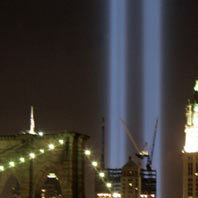TV Program Description
Original PBS Broadcast Date: September 5, 2006
Following up its Emmy Award-winning documentary, "Why the
Towers Fell," NOVA probes the conclusions of the government's
engineering investigation into the World Trade Center's
collapse on 9/11, with updated analysis of the devastating
attack and how subsequent knowledge gained will shape
skyscrapers of the future. Yet is it practical or even
possible to construct invincible buildings?
"Building on Ground Zero" features candid interviews with
leading construction and safety experts, investigators,
architects, and engineers—including Leslie Robertson,
lead structural engineer of the original World Trade Center
and Shanghai's new World Financial Center, and Jake Pauls,
occupants advocate and evacuation specialist. From the
hallways of the newly erected World Trade Center 7 in New
York, to China, where the world's tallest building is midway
to completion, NOVA explores the complex challenges of
building tall buildings in the wake of 9/11.
Previously, it was natural threats to the safety of tall
buildings—earthquakes, hurricanes, and the relentless
force of the wind—that had driven structural engineering
codes. But with the threat of terrorism, determined attackers
have targeted even the most secure structures, forcing
engineers and architects to consider what was once
unimaginable.
In the months after 9/11, NOVA followed a team of engineers
tasked by FEMA to study the Twin Towers' collapse. Preliminary
conclusions originally reported in "Why the Towers Fell"
determined that the floors of the buildings may have
"pancaked" down upon one another as their trusses failed. Now,
with the benefit of years of additional investigation, the
National Institute of Standards and Technology (NIST) has
revealed that no structural element was to blame for the
buildings' collapse.
Using vivid computer animations, NOVA takes viewers through a
simulation of what the buildings endured in the 9/11 attacks.
It turns out that fireproofing on the floor trusses was blown
off by the impact of the jets, exposing the trusses to severe
fire temperature. This caused the trusses to bow and
eventually break the buildings' supporting columns, which then
triggered the immediate collapse of the buildings. (See an
audio slide show
narrated by the chief NIST investigator.)
Forensic engineer Eugene Corley also details the chilling
results of another critical engineering investigation, that of
the bombing and destruction of the Alfred P. Murrah Federal
Building in Oklahoma City. Unlike the World Trade Center
towers, which stood for 56 minutes (South Tower) and one hour
42 minutes (North Tower), the Murrah Building crumbled in a
mere three seconds. In this worst-case scenario, known as a
progressive collapse, there was simply no time for anyone to
escape.
By standing as long as they did, the Twin Towers gave most
people a chance to escape. (Hear one survivor's remarkable
tale of escape from
high in the South Tower.) So structurally they were very
sound. But their ultimate collapse revealed fatal weaknesses
that many tall buildings share. These include stairways that
are too few and too narrow to accommodate crowds of evacuees,
fireproofing materials that are easily dislodged and could
leave steel exposed to dangerous levels of heat, and
insufficient means by which firemen and other First Responders
can reach the upper floors of a building in an emergency.
These issues and more have been addressed by NIST in a
comprehensive report that recommends 30 safety revisions to
American building codes. But as NOVA learns, these
recommendations are not without controversy among builders or
even among those in the emergency planning community. Code
changes often come with significant added costs, swift
evacuations of giant structures may not be possible, and the
probability of future terrorism is difficult to quantify. Most
experts concede that protecting buildings from airplane
attacks like those that took down the Twin Towers is simply
not practical. But many improvements can be made to a
building's design, structural integrity, and evacuation
systems that would better protect it from major fire or even
some terrorist threats, and NOVA details the ways this can be
done.
"Building on Ground Zero" takes viewers to two structures that
exemplify bold advances in skyscraper safety and construction.
In New York City, World Trade Center 7 has risen from the
ashes as one of America's safest and "greenest" tall
buildings. And in China, NOVA gets a tour from Leslie
Robertson as he guides the construction of Shanghai's new
World Financial Center, which upon completion will be the
tallest building in the world. (Hear Robertson
describe its unique design and safety features.)
Exclusive footage shows off the skyscraper's massive
structural shell, "refuge floors" with extra fire protection,
and additional elevators designed for use by emergency
personnel. While Robertson is relieved that the NIST
investigation found no flaw in his engineering of the World
Trade Center, the horror of what happened to the Towers still
haunts him to this day. In Shanghai, he is doing what many
argue we all must do: take the lessons from Ground Zero,
endorse innovation, and continue to reach for the sky.

Program Transcript
Program Credits


